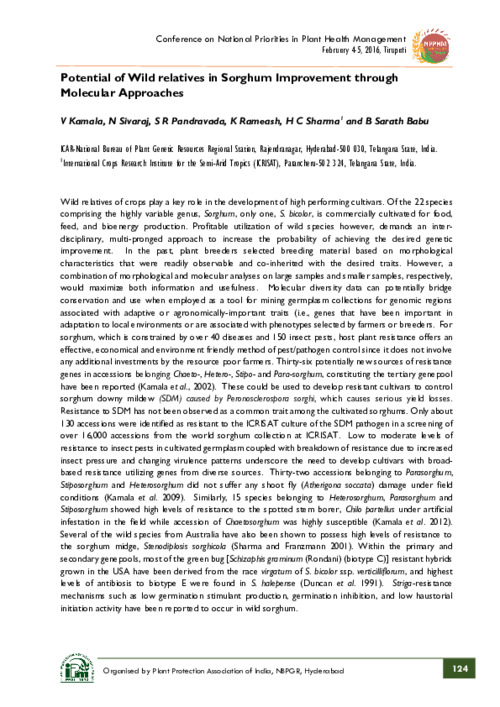Potential of Wild relatives in Sorghum Improvement through Molecular Approaches
Abstract
Wild relatives of crops play a key role in the development of high performing cultivars. Of the 22 species
comprising the highly variable genus, Sorghum, only one, S. bicolor, is commercially cultivated for food,
feed, and bioenergy production. Profitable utilization of wild species however, demands an interdisciplinary,

multi-pronged approach to increase the probability of achieving the desired genetic
improvement. In the past, plant breeders selected breeding material based on morphological
characteristics that were readily observable and co-inherited with the desired traits. However, a
combination of morphological and molecular analyses on large samples and smaller samples, respectively,
would maximize both information and usefulness. Molecular diversity data can potentially bridge
conservation and use when employed as a tool for mining germplasm collections for genomic regions
associated with adaptive or agronomically-important traits (i.e., genes that have been important in
adaptation to local environments or are associated with phenotypes selected by farmers or breeders. For
sorghum, which is constrained by over 40 diseases and 150 insect pests, host plant resistance offers an
effective, economical and environment friendly method of pest/pathogen control since it does not involve
any additional investments by the resource poor farmers. Thirty-six potentially new sources of resistance
genes in accessions belonging Chaeto-, Hetero-, Stipo- and Para-sorghum, constituting the tertiary genepool
have been reported (Kamala et al., 2002). These could be used to develop resistant cultivars to control
sorghum downy mildew (SDM) caused by Peronosclerospora sorghi, which causes serious yield losses. 
Resistance to SDM has not been observed as a common trait among the cultivated sorghums. Only about
130 accessions were identified as resistant to the ICRISAT culture of the SDM pathogen in a screening of
over 16,000 accessions from the world sorghum collection at ICRISAT. Low to moderate levels of
resistance to insect pests in cultivated germplasm coupled with breakdown of resistance due to increased
insect pressure and changing virulence patterns underscore the need to develop cultivars with broadbased
resistance
utilizing
genes
from
diverse
sources.

Thirty-two
accessions
belonging
to

Parasorghum,
Stiposorghum and Heterosorghum did not suffer any shoot fly (Atherigona soccata) damage under field
conditions (Kamala et al. 2009). Similarly, 15 species belonging to Heterosorghum, Parasorghum and
Stiposorghum showed high levels of resistance to the spotted stem borer, Chilo partellus under artificial
infestation in the field while accession of Chaetosorghum was highly susceptible (Kamala et al. 2012). 
Several of the wild species from Australia have also been shown to possess high levels of resistance to
the sorghum midge, Stenodiplosis sorghicola (Sharma and Franzmann 2001). Within the primary and
secondary genepools, most of the green bug (Schizaphis graminum (Rondani) (biotype C)) resistant hybrids
grown in the USA have been derived from the race virgatum of S. bicolor ssp. verticilliflorum, and highest
levels of antibiosis to biotype E were found in S. halepense (Duncan et al. 1991). Striga-resistance
mechanisms such as low germination stimulant production, germination inhibition, and low haustorial
initiation activity have been reported to occur in wild sorghum

